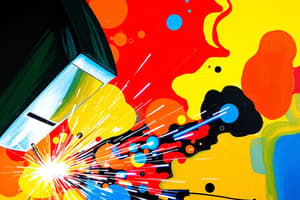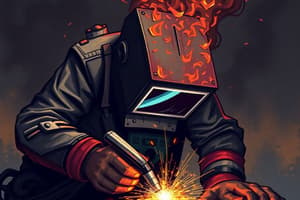Podcast
Questions and Answers
Define and describe the GMAW process in detail.
Define and describe the GMAW process in detail.
Joins metal by heating them with electric arc established between a continuously fed filler metal electrode and the workpiece.
The gas metal arc welding process is also known as:
The gas metal arc welding process is also known as:
- Robotic Welding
- Stick Welding
- TIG Welding
- MIG Welding (correct)
GMAW is recommended for use on which of the following metals?
GMAW is recommended for use on which of the following metals?
- Steel
- Aluminum
- Stainless Steel
- All of the above (correct)
List the basic equipment components required for the set-up of GMAW outfit.
List the basic equipment components required for the set-up of GMAW outfit.
How will penetration be affected when stickout is increased?
How will penetration be affected when stickout is increased?
Changing the gun inclination will:
Changing the gun inclination will:
Describe how GMAW equipment is likely to behave when the contact tip is worn out.
Describe how GMAW equipment is likely to behave when the contact tip is worn out.
Excessive splatter build up in the gun nozzle can cause:
Excessive splatter build up in the gun nozzle can cause:
Moisture and dirt on the surface of the wire electrode is likely to cause:
Moisture and dirt on the surface of the wire electrode is likely to cause:
Excessive drag from a dirty liner is likely to cause:
Excessive drag from a dirty liner is likely to cause:
When arc hunting occurs, the problem is likely in the:
When arc hunting occurs, the problem is likely in the:
Stubbing is caused by excessive:
Stubbing is caused by excessive:
List four causes of porosity.
List four causes of porosity.
Describe what whiskers are and how they are caused.
Describe what whiskers are and how they are caused.
Describe the procedure for clearing a bird nest.
Describe the procedure for clearing a bird nest.
How often should you clean the conduit liner of wire drive setup?
How often should you clean the conduit liner of wire drive setup?
What should you do when the liner becomes kinked?
What should you do when the liner becomes kinked?
List six things you should check for if the arc becomes unstable.
List six things you should check for if the arc becomes unstable.
What can result from a poor work lead connection?
What can result from a poor work lead connection?
List four things you should check for when you see porosity in the weld when using GMAW.
List four things you should check for when you see porosity in the weld when using GMAW.
The use of shielding gases for GMAW increases the need for:
The use of shielding gases for GMAW increases the need for:
High ultraviolet radiation emissions from GMAW can cause atmospheric oxygen in the vicinity of the arc to convert to:
High ultraviolet radiation emissions from GMAW can cause atmospheric oxygen in the vicinity of the arc to convert to:
A potential source of poisonous chemical fume when welding is:
A potential source of poisonous chemical fume when welding is:
Flashcards
Gas Metal Arc Welding (GMAW)
Gas Metal Arc Welding (GMAW)
A welding process using a continuously fed filler metal electrode and an electric arc to join metals.
MIG welding
MIG welding
Another name for Gas Metal Arc Welding (GMAW), often used interchangeably.
Stickout
Stickout
The distance between the contact tip and the workpiece in GMAW.
Gun Inclination
Gun Inclination
Signup and view all the flashcards
Splatter
Splatter
Signup and view all the flashcards
Porosity
Porosity
Signup and view all the flashcards
Whiskers
Whiskers
Signup and view all the flashcards
Bird Nest
Bird Nest
Signup and view all the flashcards
Liner
Liner
Signup and view all the flashcards
Contact Tip
Contact Tip
Signup and view all the flashcards
Arc Hunting
Arc Hunting
Signup and view all the flashcards
Unstable Arc
Unstable Arc
Signup and view all the flashcards
Shielding Gas
Shielding Gas
Signup and view all the flashcards
Ventilation
Ventilation
Signup and view all the flashcards
Ultraviolet Radiation
Ultraviolet Radiation
Signup and view all the flashcards
Ozone
Ozone
Signup and view all the flashcards
Chlorinated Degreasing Solvents
Chlorinated Degreasing Solvents
Signup and view all the flashcards
Lack of Penetration
Lack of Penetration
Signup and view all the flashcards
Excessive Drag
Excessive Drag
Signup and view all the flashcards
Wire Feed Speed
Wire Feed Speed
Signup and view all the flashcards
Voltage Setting
Voltage Setting
Signup and view all the flashcards
Tip-to-Work Distance
Tip-to-Work Distance
Signup and view all the flashcards
Study Notes
Gas Metal Arc Welding (GMAW) Overview
- GMAW, also known as MIG welding, joins metals using an electric arc between a continuously fed filler metal electrode and the workpiece.
- Recommended for use on various metals, making it versatile for different applications.
Equipment and Setup
- Basic components required for GMAW include voltage settings and wire speed adjustments.
- Importance of equipment maintenance is highlighted, especially monitoring the condition of the contact tip to prevent gas flow turbulence.
Welding Process Considerations
- Increasing stickout will decrease penetration in welds.
- Gun inclination affects both penetration depth and the feeding smoothness of the wire.
- Managing excessive splatter and dirt build-up in the gun nozzle is crucial to ensure adequate gas coverage during welding.
Common Issues and Solutions
- Moisture and dirt on the wire electrode can cause porosity in welds, compromising quality.
- Dirty liners can lead to excessive drag, damaging the liner and contact tip.
- Arc hunting indicates potential issues with the wire feeder drive motor or gearbox.
Porosity and Defects
- Common causes of porosity include insufficient gas coverage, wet shielding gas, excessive tip-to-work distance, and high gas flow.
- Whiskers are unmelted wire protrusions from the groove, often caused by an incorrect root opening or face thickness.
Maintenance Procedures
- Clearing a "bird nest" requires de-energizing equipment, removing the wire, and cleaning or replacing parts as necessary.
- Liner cleaning should occur every time the wire spool is changed; kinked liners must be replaced or repaired using approved fittings.
Addressing Unstable Arcs
- When experiencing an unstable arc, check for loose cable connections, worn contact tips, and secure work lead connections.
- Poor connections can lead to unstable arcs.
Troubleshooting Porosity
- Solutions for porosity issues include increasing gas flow, eliminating spatter buildup, and ensuring gas lines are clear of leaks.
Safety Considerations
- The use of shielding gases in GMAW necessitates good ventilation to ensure safety during operation.
- High ultraviolet radiation from GMAW can convert atmospheric oxygen into ozone, posing additional health risks.
- Chlorinated degreasing solvents are a source of poisonous fumes, underscoring the need for proper safety measures.
Studying That Suits You
Use AI to generate personalized quizzes and flashcards to suit your learning preferences.




